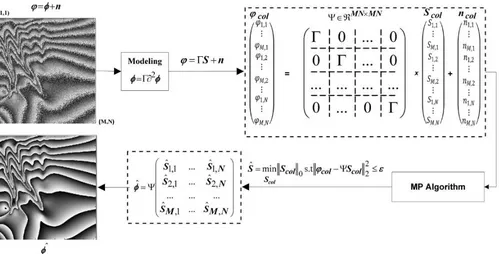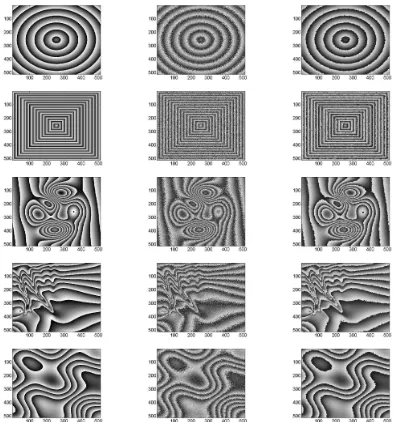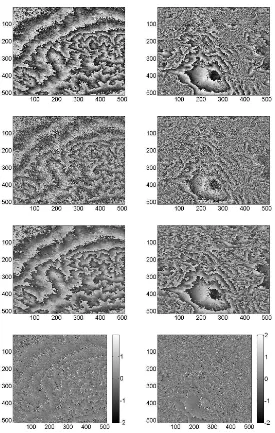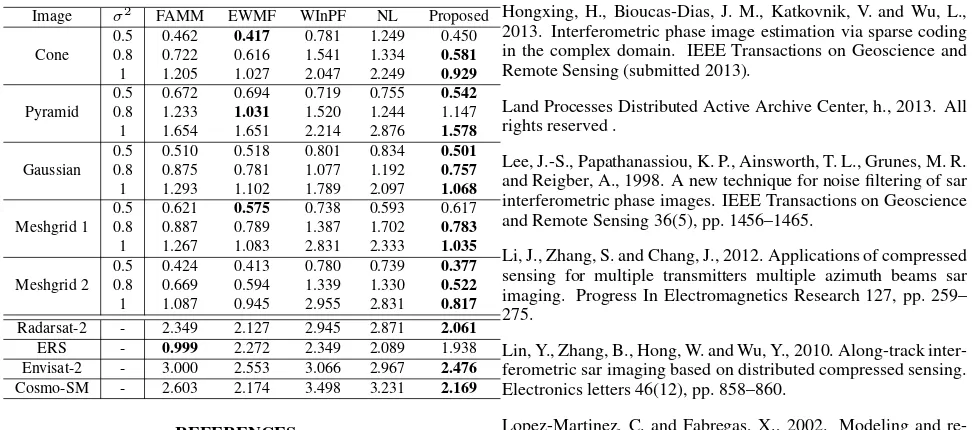NEW SAR INTERFEROGRAM DENOISING METHOD VIA SPARSE RECOVERY BASED
ON
L
0NORM
Wajih Ben Abdallaha, Riadh Abdelfattaha,b a
COSIM Lab, University of Carthage, Higher School Of Communications of Tunis
Route de Raoued KM 3.5, Cite El Ghazala Ariana 2083 - Tunisia, email:[email protected] b
D´epartement ITI, T´el´ecom Bretagne, Institut de T´el´ecom, Technopˆole Brest-Iroise CS 83818 29238 Brest Cedex 3 - France, email:[email protected]
KEY WORDS:Interferogram filtering, phase estimation, sparse coding,l0minimization, approximate message passing.
ABSTRACT:
The goal of this paper is to estimate a denoised phase image from the observed noisy SAR interferogram. We proposed a linear model to obtain a sparse representation of the interferomteric phase image. The main idea is based on the smoothness property of the phases inside interferometric fringes which leads to get a sparse image when applying the gradient operator twice, alongxorydirection, on the interferogram. The new sparse representation of the interferometric phase image allows to transform the denoising problem to an optimization one. So the estimated interferogram is achieved using the approximate message passing algorithm. The proposed approach is validated on different cases of simulated and real interferograms.
1. INTRODUCTION
The SAR interferogram (InSAR) filtering is a fundamental step before phase unwrapping process. Several filters have been pro-posed last decades, many of them are spatial filters (Lee et al., 1998), (Baran et al., 2003), (Abdallah and Abdelfattah, 2013) or filters opertaed in wavelet domain (Lopez-Martinez and Fabre-gas, 2002), (Bian and Mercer, 2011) and (Chang et al., 2011). Since the compressed sensing (CS) technique was invented by Donoho in2006(Donoho, 2006), it has been used in the SAR images context. Most of the proposed appraoches were intended to the polarimetric SAR data such as (Si et al., 2009), (Lin et al., 2010) and (Li et al., 2012). Other approaches are dedictaed to the object detection in the SAR images (Anitori et al., 2013) and (Ahmad et al., 2013). In the case of the InSAR denoising, few fil-tering algorithms are proposed and they are mostly based on the sparsity context rather than the CS technique. For example, mary
et al. proposed a sparse denoising approach of the
interferomet-ric data by extracting geometinterferomet-rical features of the images (Mary et al., 2010). In (Hao et al., 2013), the authors used a sparse representation and a generated dictionary to estimate the noise free phase from a noisy InSAR. In this paper, we propose a new approach for interferometric phase image denoising using sparse coding. Our idea is based on the fact that the original phase image without noise should be smooth within the fringes. This property allows us to obtain a sparse representation of the image to esti-mate if we apply the gradient operator. The elements of the result image will be close to0except the pixels in the edges of fringes. Next, the filtered interferometric image can be estimated by solv-ing thel0minimization problem of the obtained sparse represen-tation. This minimization problem is achieved using the approx-imate message passing algorithm (Vila and Schniter, 2012). The rest of this paper is organised as follows. Section 2 is dedicated to present the proposed sparse model and the formulation of the optimization problem, section 3 presents the experimental results and discussions and we finish by concluding in section 4.
2. THE PROPOSED SPARSE MODEL FOR INTERFEROGRAM DENOISING
In this section we present a model of the interferometric phase image based on a sparse representation. The observed noisy in-terferogramϕcan be considered as aM×Nimage as following (Lee et al., 1998):
ϕ=φ+n (1)
whereφdenotes the interferometric phase image without noise andnis the noise. The denoising problem aims to estimate the phaseφfrom the observed oneϕ. Our goal is to rewrite the ex-pression ofφwith a sparse representation. For this reason, we as-sume that the phase imageφshould be smooth inside the fringes i.e the difference between two neighbours phases in the same fringe should be small. In fact, the phase stationarity in homoge-neous areas of the interferogram is ensured by the removal of the orbital component from the phase images before the generation of the interferometric phase image (Deledalle et al., 2011). But, in case of almost reliefs, the variation of the phase within a given interferometric fringe could be important and our hypothesis is not necessary valid. For this reason, and in order to insure the applicability of the sparse representation we apply the gradient operator twice. So we use the gradient operators twice alongxor ydirection to compute the phase difference between neighbours pixels as follows:
We obtain the second order derivative (∂2
) of the interferometric phase imageφusing a simple linear formulation:
∂2
xφ=Sx=φGT
∂2
yφ=Sy=Gφ (3)
Figure 1: Flowchart of the proposed approach for SAR interferometric denoising via sparse recovery.
whereGis aM×Mmatrix having the following structure:
G=
An alternative of this sparse representation could be the Laplacien of the interferometric phase. However, the linear expression of that is very complicated.
So, as mentioned aboveSxandSycan be considered as sparse
matrices whose almost of their elements are close to0except the pixels located at the edges of the fringes. Since the treatments along two directions are symmetric to each other, in the rest of this paper we will interested only onydirection.
So now we can express the unknown phase imageφwith a sparse representation usingΓ = G−1
which is expressed as a lower triangular matrix:
The next step is to construct the vectorsϕcolandφcolcontaining
respectively the elements ofϕandφarranged column by column. By the same way, we generate the vectorsScolandncolfromSy
andnrespectively. So the size of these vectors isM N×1. Also, we define the diagonal matrixΨ∈ ℜM N×M Nas following:
According to (3) we can write:
φcol= ΨScol (7)
And the final sparse representation of (1) becomes:
ϕcol= ΨScol+ncol (8)
According to (7), the estimate of the noise free phaseφis given byφˆcol = Ψ ˆScolwhenSˆcol is the solution of the followingl0
wherekScolk0denotes the norml0that gives the number of nonzero elements ofsandǫis a given parameter to control the error rate. By minimizing the number of nonzeor ofScol, the homogeneous
Figure 2: Simulated interferograms filtering results. From top to bottom: cone, pyramid, Gaussian variation, first meshgrid function and second meshgrid function. From left to right: the original interferograms without noise, the corresponding noisy interferograms withσ2
= 0.8and the filtered results with the proposed approach.
3. EXPERIMENTAL RESULTS AND DISCUSSIONS
3.1 Results from simulated interferograms
We begin our validation tests with five different simulated inter-ferograms with512×512pixels size representing respectively a cone, a pyramid, a Gaussian variation and two phase images gen-erated using meshgrid function in MATLAB as shown in Fig. 2. First, we filtered the simulated interferograms affected by a white Gaussian noise withσ2
= 0.8. Fprǫ, we assume that the error rate between the estimated phaseφˆand the observed oneϕfor one pixel should not exceed1000π . So for the whole phase image with sizeN ×N the global error rateǫwill be compute as the sum of local error rate
ǫ=N2 π
1000 (10)
note that more details about the relationship between the noise variance and the estimaton error threshold is given in (Hongxing
et al., 2013).
For the filtering results, we notice that the proposed approach reduce noise inside fringes very well. It denoise perfectly the homogeneous areas of the interferograms and therefore it gives lower Mean Square Error (MSE) values with respect to noise level as shown in Table 1. Thus, the great advantage of the pro-posed algorithm is that it preserves the edges of the fringes forms. As quantitative comparison, we compute the MSE between the original phase image without noise and the filtered interferograms using FAMM (Abdelfattah and Bouzid, 2008), EWMF (Abdallah and Abdelfattah, 2013), WInPF (Lopez-Martinez and Fabregas, 2002), NL-InSAR (Deledalle et al., 2011) and the proposed algo-rithm. Table 1 shows the different MSE values when varying the noise level. We notice that the proposed filtering approach gives, globally, the best MSE values except in few cases.
3.2 Results from real interferograms
For the real SAR interferograms, we used four different phase im-ages produced from SLC pairs of Radarsat-2, ERS-2, Envisat and Cosmo-SkyMed satellites respectively. All informations about The International Archives of the Photogrammetry, Remote Sensing and Spatial Information Sciences, Volume XL-7, 2014
Figure 3: Real interferograms filtering results. The first column using Radarsat-2 interferogram and the second column using ERS satellite and from top to bottom: the original interferogram produced from ASTER DEM, the observed noisy interferogram, filtered with the proposed approach and the filtering error with respect to column 1.
these four InSAR are available in (Ben Abdallah and Abdelfattah, 2013). All tested real images are512×512pixels size. Similar to the simulated data, we consider the interferogram generated by wrapping the Digital Elevation Model (DEM) provided by ASTER Global DEM available in the Land Processes Distributed Active Archive Center website (Land Processes Distributed Ac-tive Archive Center, 2013) as the original interferogram without noise. Note that since the four satellites, mentioned above, having different spatial resolutions, we should make under or over sam-pling to their InSARs to obtain the same resolution of ASTER’s interferogram (30×30meters). Next, we compare the filtering results of the four InSARs with the reference one generated from ASTER’s DEM. In Fig. 3, we illustrate our estimation result and the corresponding error map. For the statistical comparison, the second part of the Table 1 shows that the proposed approach gives lower error rate for the four real InSAR except in the case of ERS satellite data.
4. CONCLUSION
Table 1: Mean Square Error (MSE) computed using different fil-tering algorithms. The first part of table: MSE of simulated inter-ferograms with different noise variances. The second part: MSE between interferograms obtained using ASTER’s DEM and the filtered ones.
Image σ2 FAMM EWMF WInPF NL Proposed
0.5 0.462 0.417 0.781 1.249 0.450 Cone 0.8 0.722 0.616 1.541 1.334 0.581
1 1.205 1.027 2.047 2.249 0.929
0.5 0.672 0.694 0.719 0.755 0.542
Pyramid 0.8 1.233 1.031 1.520 1.244 1.147 1 1.654 1.651 2.214 2.876 1.578
0.5 0.510 0.518 0.801 0.834 0.501
Gaussian 0.8 0.875 0.781 1.077 1.192 0.757
1 1.293 1.102 1.789 2.097 1.068
0.5 0.621 0.575 0.738 0.593 0.617 Meshgrid 1 0.8 0.887 0.789 1.387 1.702 0.783
1 1.267 1.083 2.831 2.333 1.035
0.5 0.424 0.413 0.780 0.739 0.377
Meshgrid 2 0.8 0.669 0.594 1.339 1.330 0.522
1 1.087 0.945 2.955 2.831 0.817
Radarsat-2 - 2.349 2.127 2.945 2.871 2.061
ERS - 0.999 2.272 2.349 2.089 1.938 Envisat-2 - 3.000 2.553 3.066 2.967 2.476
Cosmo-SM - 2.603 2.174 3.498 3.231 2.169
REFERENCES
Abdallah, W. B. and Abdelfattah, R., 2013. An enhanced weighted median filter for noise reduction in sar interferograms. Advanced Concepts for Intelligent Vision Systems pp. 49–59.
Abdelfattah, R. and Bouzid, A., 2008. Sar interferogram filtering in the wavelet domain using a coherence map mask. 15th IEEE International Conference on Image Processing pp. 1888–1891.
Ahmad, F., Jiang, Q. and Moeness, G. A., 2013. Wall mitiga-tion using discrete prolate spheroidal sequences for sparse indoor image reconstruction. EURASIP.
Anitori, L., van Rossum, W., Otten, M., Maleki, A. and Bara-niuk, R., 2013. Compressive sensing radar: Simulation and ex-periments for target detection. EURASIP.
Baran, I., Stewart, M. P., Kampes, B. M., Perski, Z. and Lilly, P., 2003. A modification to the goldstein radar interferogram fil-ter. IEEE Transactions on Geoscience and Remote Sensing 41(9), pp. 2114–2118.
Ben Abdallah, W. and Abdelfattah, R., 2013. A comparative study on the performance of the insar phase filtering approches in the spatial and the wavelet domains. ISPRS Journal of Pho-togrammetry and Remote Sensing 40(7), pp. 43–48.
Bian, Y. and Mercer, B., 2011. Interferometric sar phase filter-ing in the wavelet domain usfilter-ing simultaneous detection and esti-mation. IEEE Transactions on Geoscience and Remote Sensing 49(4), pp. 1396–1416.
Chang, L., He, X. and Li, J., 2011. A wavelet domain detail compensation filtering technique for insar interferograms. Inter-national Journal of Remote Sensing 32(23), pp. 7985–7995.
Chen, S. S., Donoho, D. L. and Saunders, M. A., 2001. Atomic decomposition by basis pursuit. SIAM Review 43(1), pp. 129– 159.
Deledalle, C.-A., Denis, L. and Tupin, F., 2011. Nl-insar: Non-local interferogram estimation. Geoscience and Remote Sensing, IEEE Transactions on 49(4), pp. 1441–1452.
Donoho, D. L., 2006. Compressed sensing. IEEE Transactions on Information Theory 52(4), pp. 1289–1306.
Hao, H., Jos´e, M. B.-D., Vladimir, K. and Lingda, W., 2013. Interferometric phase image estimation via sparse coding in the complex domain. IEEE Transactions on Geoscience and Remote Sensing.
Hongxing, H., Bioucas-Dias, J. M., Katkovnik, V. and Wu, L., 2013. Interferometric phase image estimation via sparse coding in the complex domain. IEEE Transactions on Geoscience and Remote Sensing (submitted 2013).
Land Processes Distributed Active Archive Center, h., 2013. All rights reserved .
Lee, J.-S., Papathanassiou, K. P., Ainsworth, T. L., Grunes, M. R. and Reigber, A., 1998. A new technique for noise filtering of sar interferometric phase images. IEEE Transactions on Geoscience and Remote Sensing 36(5), pp. 1456–1465.
Li, J., Zhang, S. and Chang, J., 2012. Applications of compressed sensing for multiple transmitters multiple azimuth beams sar imaging. Progress In Electromagnetics Research 127, pp. 259– 275.
Lin, Y., Zhang, B., Hong, W. and Wu, Y., 2010. Along-track inter-ferometric sar imaging based on distributed compressed sensing. Electronics letters 46(12), pp. 858–860.
Lopez-Martinez, C. and Fabregas, X., 2002. Modeling and re-duction of sar interferometric phase noise in the wavelet domain. IEEE Transactions on Geoscience and Remote Sensing 40(12), pp. 2553–2566.
Mallat, S. and Zhang, Z., 1993. Matching pursuits with time-frequency dictionaries. IEEE Transactions on Signal Processing pp. 3397–3415.
Mary, D., Bourguignon, S., Theys, C. and Lanteri, H., 2010. In-terferometric image reconstruction with sparse priors in union of bases,”. Astronomical Data Conference.
Mohimani, H., Babaie-Zadeh, M., Gorodnitsky, I. and Jutten, C., 2010. Sparse recovery using smoothed l0: Convergence analysis. arXiv preprint arXiv:1001.5073.
Si, X., Jiao, L., Yu, H., Yang, D. and Feng, H., 2009. Sar images reconstruction based on compressive sensing. 2nd Asian-Pacific Conference on Synthetic Aperture Radar pp. 1056–1059.
Vila, J. and Schniter, P., 2012. Expectation-maximization gaussian-mixture approximate message passing. 46th Annual Conference on Information Sciences and Systems (CISS) pp. 1– 6.



